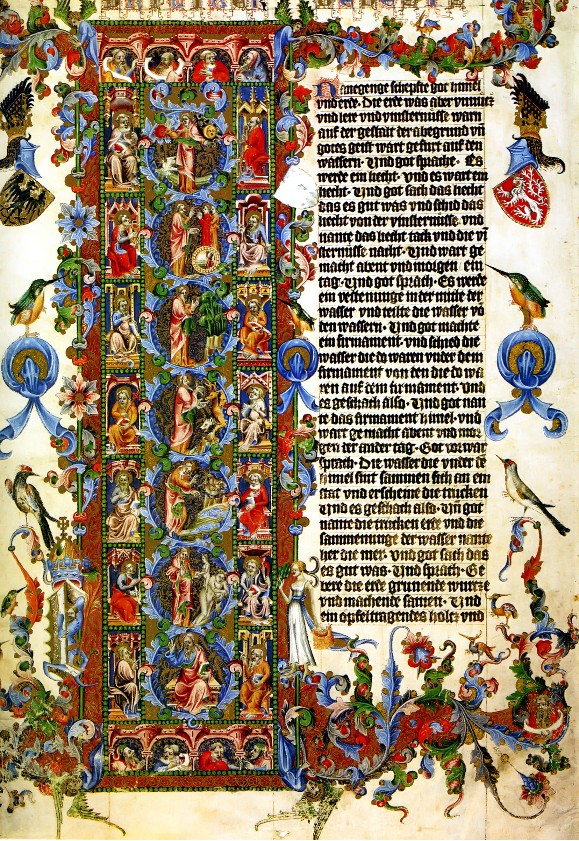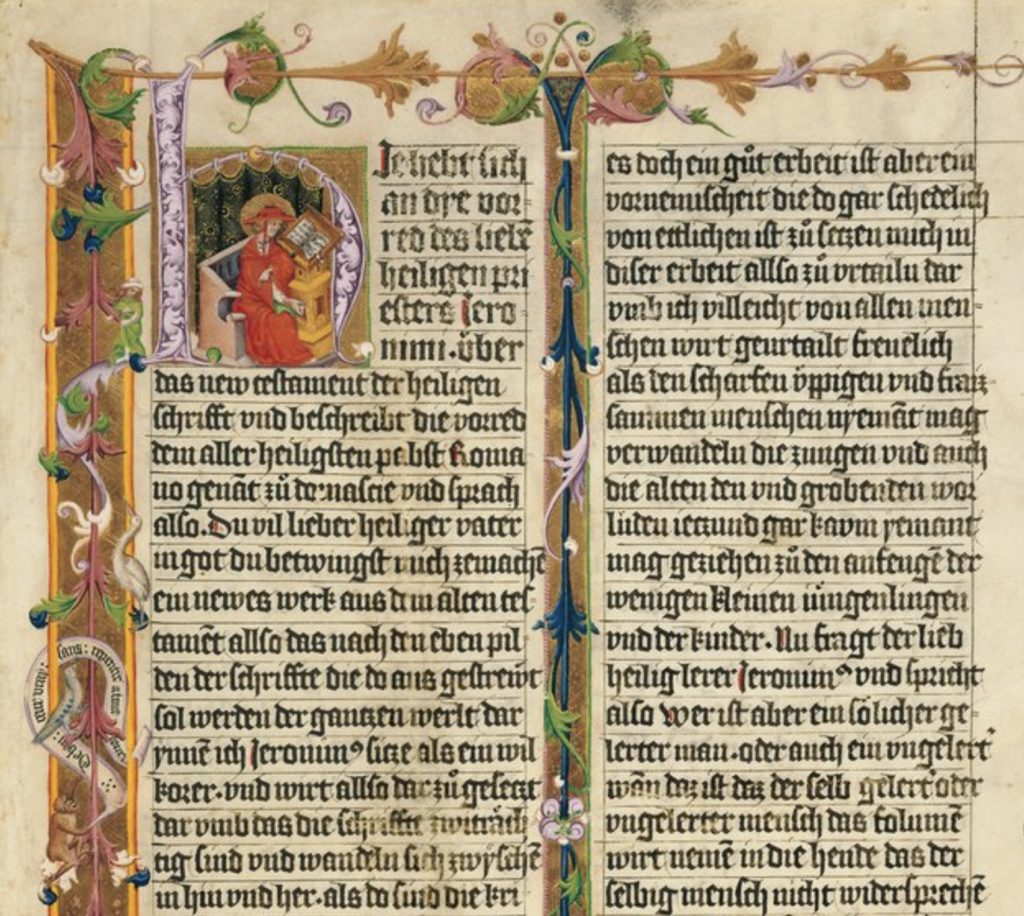Hymnography (Greek: ὑμνογραφία) is one of the most prolific and creative genres of Christian literature, especially Byzantine. The word hymn (ὕμνος) means a song of religious content composed for liturgical use. Christian worship included the singing of hymns from the very beginning (Matt. 26:30; Eph. 1: 3-14). The Holy Scriptures, as the most important source and content of Christian worship, inspire and permeate church hymns, many of which represent a true “mosaic of biblical words and phrases” (Lash 2008, 35). Thus, the earliest Christian hymns developed from the singing of psalms and biblical odes, and then from non-biblical refrains and antiphons, which were inserted between biblical verses (Frøyshov 2013).
Unlike the traditional approach, where the focus was on the historical and literary characteristics of hymnography, recent scholarship emphasizes its exegetical significance (Wickes 2019; Pentiuc 2021). The roots of exegetical hymnography can be found in the hymn On Pascha by Melito of Sardis (d. ca 180). Chapter 12 of the Book of Exodus is retold in its first part, while in the second the significance of that narrative is presented. However, exegetical hymnography gained its real momentum in the 4th century among the Syrian-speaking Christians with Ephrem the Syrian (d. 373) and his hymns known as madrasha. The main characteristic of madrasha is that it is based on biblical texts and gives their interpretations. Somewhat later, under the influence of madrasha, but also other genres of Syrian hymnography, such as mêmrê (a metrical sermon) and soghitha (a responsory song in the form of dialogues) (Brock 1983; Brock 1989), the kontakion appeared in the Greek tradition (Maas 1910; Brock 1989). This hymnographic genre, which flourished in the 6th and 7th centuries, was a type of biblical commentary–sometimes called “sung homily”–in which the poet used dialogues and elaboration of the biblical text in order to convey the content of the Holy Scriptures to the public, i.e. the gathered congregation. The most important representative of this hymnographic genre is Romanos the Melodist (d. after 555), to whom a large number of kontakia are attributed, of which approximately sixty are authentic (Maas and Trypanis 1963).

The last great hymnographic genre, even though not the last to appear, is the kanon. Its beginnings date back to the 4th-5th centuries (Frøyshov 2013), but, thanks to several prominent hymnographers, such as Andrew of Crete (d. 740), John of Damascus (d. ca 750) and Kosmas the Melodist (d. ca 752), the kanon eventually prevailed from the 8th century as the most represented hymnographic genre in the Byzantine liturgical tradition. Based on nine biblical odes, the structure of the kanon summarizes the entire history of salvation from the passage of the Jews through the Red Sea (ode 1) to the incarnation of Christ (ode 9).

Hymnography is permeated with virtually all biblical readings, while hymnographers, using both previously mentioned and other genres to provide their interpretation of specific biblical verses, employ methods that overcome divisions both among biblical books and between the Old and New Testaments. Christian poets, therefore, used hymnographic forms to interpret the Holy Scriptures, but also to revive, actualize and reenact them in a certain way at liturgical gatherings (Merton 1956; Krueger, 2015). Therefore, in addition to typology and allegory as the two primary exegetical methods in hymnography, we should also mention the remarkably widespread practice of reworking, supplementing and even rewriting the Bible in liturgical hymns (Bucur 2007). Namely, instead of establishing a connection between a certain Old Testament and New Testament event or person, achieved by employing typology, or instead of searching for the spiritual reality behind an Old Testament narrative, which is characteristic of allegory, hymnographers rework and supplement biblical narratives and adapt them to specific contexts. In this process of elaborating or a kind of rewriting the biblical text, we see a rhetorical technique quite common for late antique and Byzantine hymnography, i.e. inventing speeches for biblical characters (prosopopeia or personification) or constructing dialogues between them. Such fictional speeches and dialogues have served various purposes, such as explaining silence in a text, attaching a certain theological meaning to the text, or developing the psychological profile of a particular biblical figure. Among the most illustrative examples are undoubtedly fictional dialogues between biblical protagonists that we meet in the hymnography of great feasts, such as Christmas (between the Mother of God and the Infant Jesus), Epiphany (between Christ and John the Baptist), Presentation of Jesus at the Temple (between Simeon and the Infant Jesus), etc.
In conclusion, it can be said that classical Byzantine biblical commentaries and hymnography are mutually complementary. Moreover, if we accept as the point of departure the fact that the liturgical space is the context in which the Holy Scriptures are listened to and interpreted, then this is already a major step towards recognizing hymnography as a privileged bearer of biblical exegesis. Finally, if we keep in mind that we no longer have systematic biblical commentaries in the Christian East since the 6th century, and especially in the post-iconoclastic period, which coincides with the flourishing of hymnography, we can claim that hymnography takes over that role to some extent. Therefore, it is impossible to fully assess the reach and value of the medieval biblical exegesis of the Orthodox East if hymnography is not taken into account.
Kosta Simic
Byzantine Postdoctoral Fellow, Medieval Institute
University of Notre Dame (2021-2022)
Further Reading:
Brock, Sebastian. “Dialogue Hymns of the Syriac Churches”. Sobornost incorporating Eastern Churches Review 5:2 (1983) 35–45
______. “From Ephrem to Romanos”. In Studia Patristica 20, edited by Elizabeth A. Livingstone, 139–151. Leuven: Peeters, 1989.
Bucur, Bogdan. “Exegesis of Biblical Theophanies in Byzantine Hymnography: Rewritten Bible?”, Theological Studies 68 (2007) 92-112.
Frøyshov, Stig. ‘Byzantine Rite’, ‘Rite of Constantinople’ and ‘Rite of Jerusalem’, in The Canterbury Dictionary of Hymnology at:https://hymnology.hymnsam.co.uk/ b/byzantine-rite [by subscription], 2013.
Gador-Whyte, Sarah. Theology and Poetry in Early Byzantium: The Kontakia of Romanos the Melodist, Cambridge: Cambridge University Press, 2017.
Grosdidier de Matons, José Grosdidier. Romanos le Mélode et les origines de la poésie religieuse à Byzance, Paris: Éditions Beauchesne, 1977.
—. “Liturgie et Hymnographie: Kontakion et Canon”, Dumbarton Oaks Papers 34 (1980–81) 31-43.
Hall, Stuart George. Melito of Sardis “On Pascha” and Fragments, Oxford: Clarendon, 1979.
Lash, Ephrem. “Biblical Interpretation in Worship”. In The Cambridge Companion to Orthodox Christian Theology, edited by Mary Cunningham and Elizabeth Theokritoff, 35–48. Cambridge: Cambridge University Press, 2008.
Hannick, Christian. “The Theotokos in Byzantine Hymnography: Typology and Allegory”. In Images of the Mother of God. Perceptions of the Theotokos in Byzantium, edited by Maria Vassilaki, 69-76. Aldershot: Ashgate, 2005.
“Hymnography”. In The Oxford Dictionary of Byzantium, vol. 2, edited by Alexander Kazhdan et al., 960-961. Oxford and New York: Oxford University Press, 1991.
Krueger, Derek. “Liturgical Time and Holy Land Reliquaries in Early Byzantium”. In Saints and Sacred Matter: The Cult of Relics in Byzantium and Beyond, edited by Cynthia Hahn and Holger A. Klein, 110-131. Washington, D.C.: Dumbarton Oaks Research Library and Collection, 2015.
Maas, Paul. “Das Kontakion”. Byzantinische Zeitschrift 19 (1910) 285–306.
Maas, Paul and Trypanis, Constantine Athanasius (eds). Sancti Romani Melodi Cantica: Cantica Genuina, Oxford: Clarendon Press, 1963.
Merton, Thomas. “Time and Liturgy”, Worship 31 (1956) 2-10.
Pentiuc, Eugen. Hearing the Scriptures: Liturgical Exegesis of the Old Testament in Byzantine Orthodox Hymnography. Oxford: Oxford University Press, 2021.
Wellesz, Egon. A History of Byzantine Music and Hymnography, Oxford: Clarendon Press, 1961.
Wickes, Jeffrey. “Poetry and Hymnody”. In The Oxford Handbook of Early Christian Biblical Interpretation, edited by Paul Blowers and Peter Martens, 254-269. Oxford: Oxford University Press, 2019.


